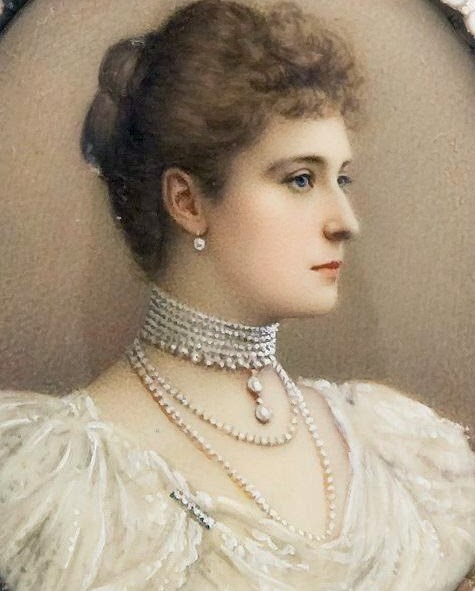They are two of the most tragic consorts in history, both having the blood of Mary Stuart. I think that the Queen of France had the more tragic life. Alexandra got to marry her great love and that makes all the difference in the world. Louis and Antoinette loved each other, but few loves can compare with the grand passion of Nicky and Alix. Both women were devoted to their children and tried to have a real family life with them. Both loved the "simple life" and tried to create quiet refuges amid the splendor of the court. Both women were vilified in ways that transcended all reality by their political enemies. In order to pull apart a family, destroy the image of the mother; in order to bring a nation into revolution, then destroy the reputation/image of the queen/empress, who was the mother-figure of the people. If they could convince the people that the queen/empress was evil and that the king/tsar was an idiot, then it meant the children were no good and the entire family should be gotten rid of.
It was a deliberate ploy. Antoinette and Alexandra are tragic because no matter what they did it played into the hands of their enemies. The Great Catherine outwardly had lovers and no one held it against her and she was loved by the people. Napoleon's Josephine spent more money on clothes in one year than Marie-Antoinette did in her entire life and yet Josephine was popular with the French people. It is sad that two women of virtue like Antoinette and Alexandra should be so terribly misunderstood.
There are other connections between the two consorts. Here are some reflections from Royal Central:
In the year of their coronation in 1896, Tsar Nicholas II and Tsarina Alexandra Feodorovna made a vital State Visit to France, during which the foundation stone of the elegant Pont Alexandre III was laid. The ‘Hesse Princesses’ of Marie Antoinette’s youth made a family trip to Paris in 1780, with their father, Prince George William of Hesse. As part of this visit, Marie Antoinette invited Princess Louise, the future Landgravine of Hesse, her husband, Prince Louis and her brother, Prince Frederick of Hesse, to visit her beloved private retreat of the Petit Trianon. This was a sure sign of royal favour: ‘It’s looking so beautiful that I should be charmed to show it to you’ (Ibid, Pg 210). During a performance at Versailles, Princess Charlotte even sat in the Queen’s box at the opera (Ibid, Pg 210).
As part of the Russian Imperial State Visit, Alexandra was ‘assigned’ the rooms of Marie Antoinette at Versailles for one night. If she considered her Hesse forebears having been invited to Versailles in 1780, she made no mention of it. Alexandra was directly related to Landgravine Louise, as Antonia Fraser has observed, as her fourth cousin, four generations removed (Ibid, Pg 538). Alexandra’s father, Grand Duke Ludwig IV, was the nephew of Grand Duke Ludwig III of Hesse – the grandson of Grand Duke Ludwig I – as Landgravine Louise’s husband became known, the title of Hesse becoming Hesse and by Rhine in 1816. According to Antonia Fraser’s biography, Alexandra was “delighted” (Ibid, Pg 538) with being given Marie Antoinette’s rooms, which presumably, given the fact that she stayed overnight, must have been the glorious Queen’s State Bedchamber, as there is no mention of the Trianon, nor did Marie Antoinette’s private quarters contain her bed. Alexandra’s biographer, Greg King, states that in Marie Antoinette’s rooms, Alexandra spent the night underneath “the damask canopy of the doomed queen’s bed”, citing Alexandra’s earlier biographer Baroness Buxhoeveden, for this (Greg King, The Last Empress, Pg 115, 1994).My book Marie-Antoinette: Daughter of the Caesars has a great deal about Marie-Antoinette's friendships with the Hesse sisters as well as her friendships with the future Tsar Paul and his wife Maria Feodorovna, ancestors of Nicholas II.
As a result of this visit, Alexandra would later tell her daughters, the four Grand Duchesses, tales of Paris and Versailles, according to Buxhoeveden (Baroness Sophie Buxhoeveden, The Life & Tragedy of Alexandra Feodorovna, 1928). Alexandra’s suite, by contrast, had found the fact that the young Tsarina had been given Marie Antoinette’s rooms at Versailles “ominous”, while the Tsarina herself was “thrilled” by Versailles (Ibid, Pg 75). In a pleasant parallel to the theatrical performance given for Marie Antoinette’s ‘Hesse Princesses’, the Tsarina attended a theatrical performance at Versailles with the Tsar, in the Salon d’Hercule (Ibid, Pg 75).
There were other associations, however. According to Marfa Mouchanow’s 1918 book My Empress, Alexandra had the Imperial Bedroom at the Winter Palace used by herself and Tsar Nicholas, hung with silk, itself inspired by a pattern used in Marie Antoinette’s rooms at the chateau of Fontainebleau (King, Pg 90). (Read more.)





















1 comment:
In both cases, and even to this day, the 'media' is in the forefront of spreading negative information. The 'press' is free to interpret and print whatever suits their purposes in order to manipulate public thought and discourse which negates the people's free choice. The danger in this is that entire governments and/or monarchies have been destroyed as well as innocent reputations and lives, and in many cases even the lives of the children involved.
Post a Comment